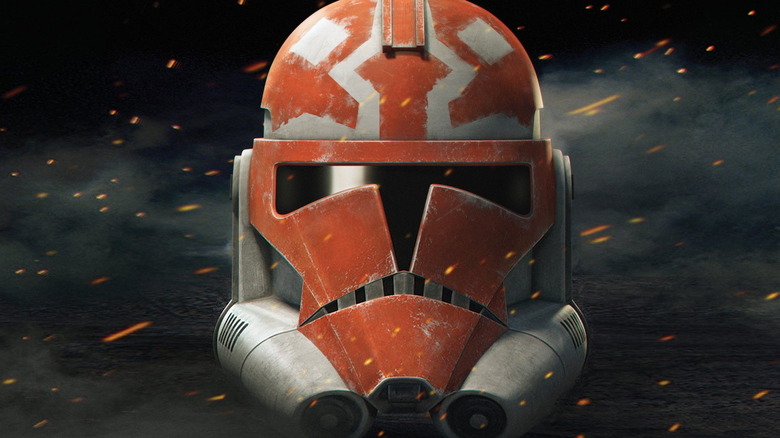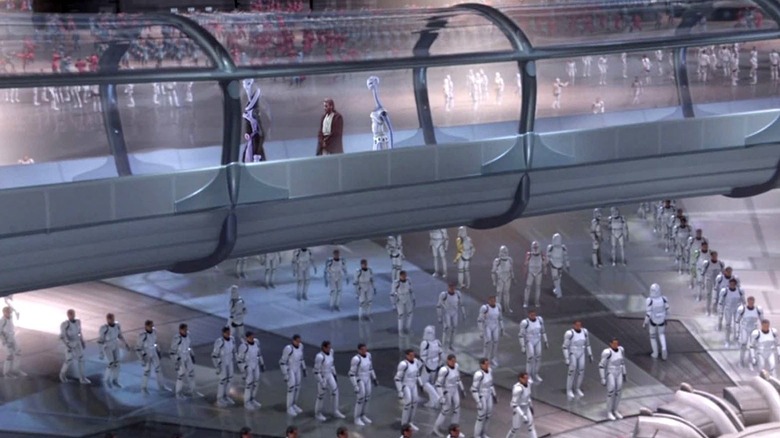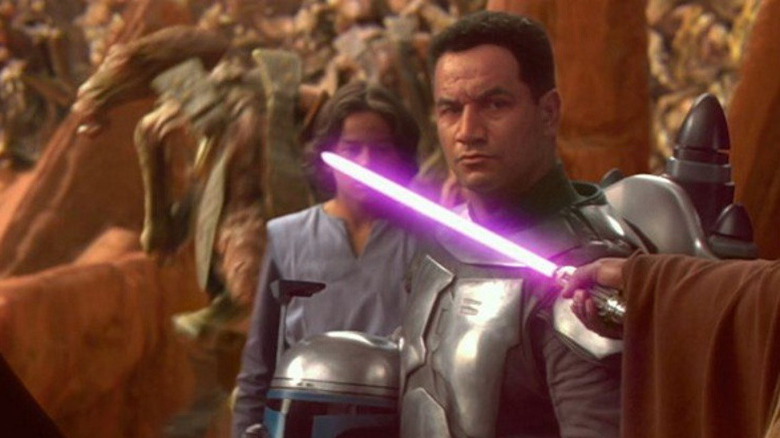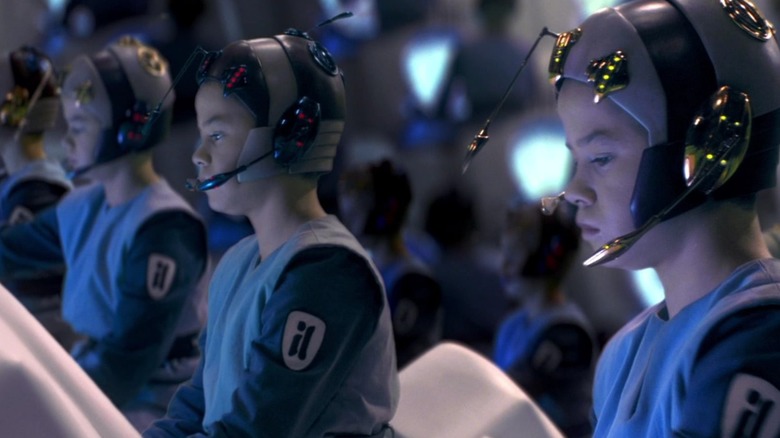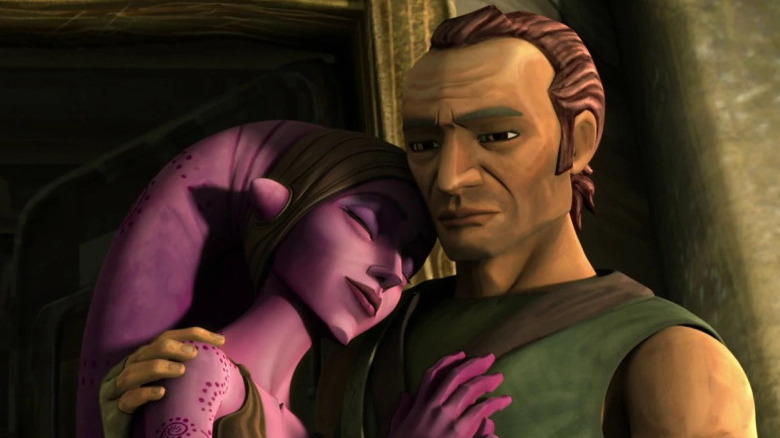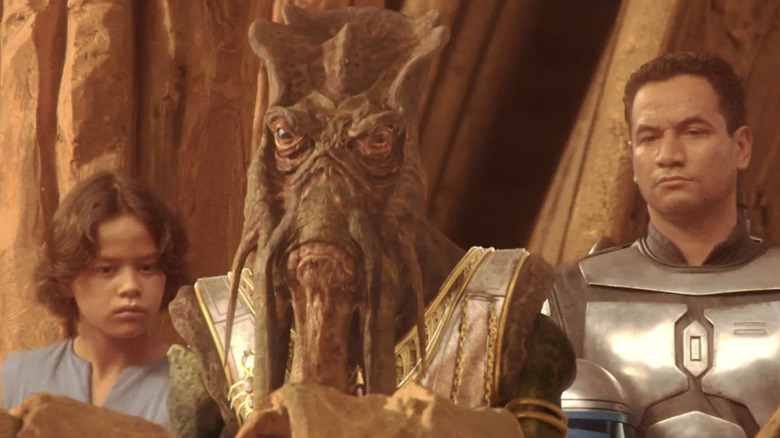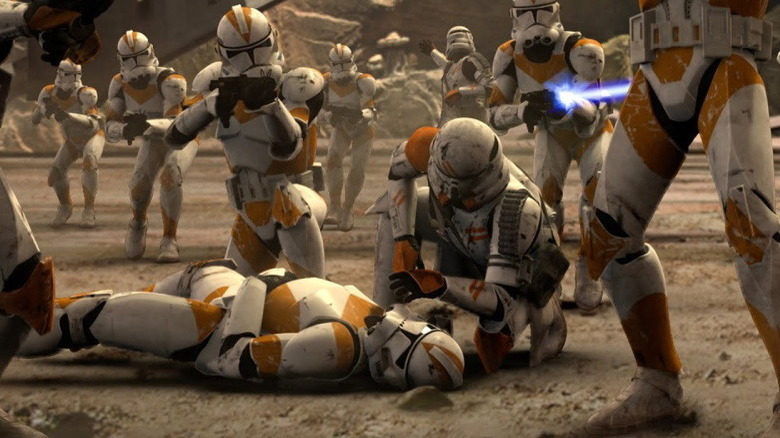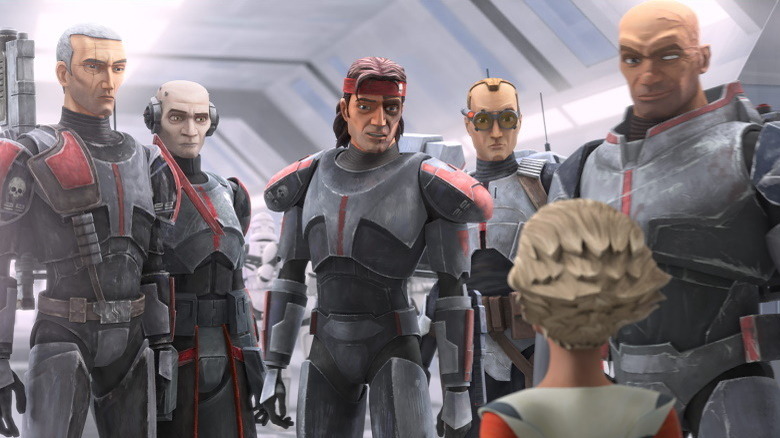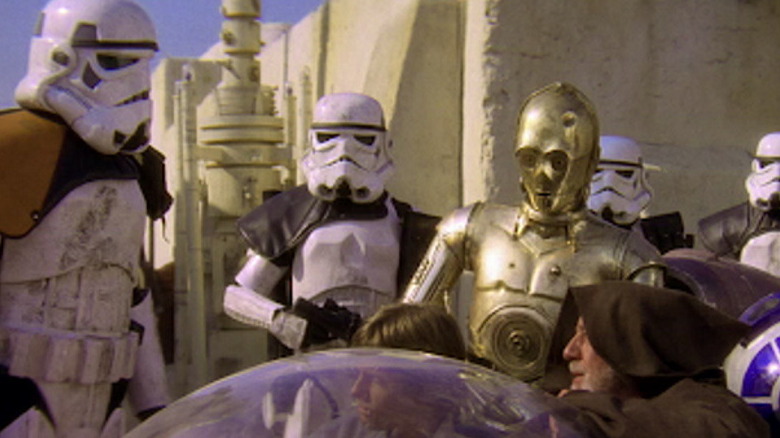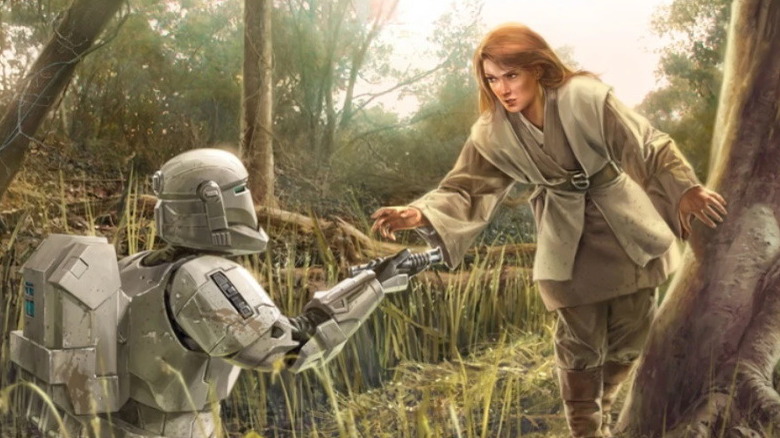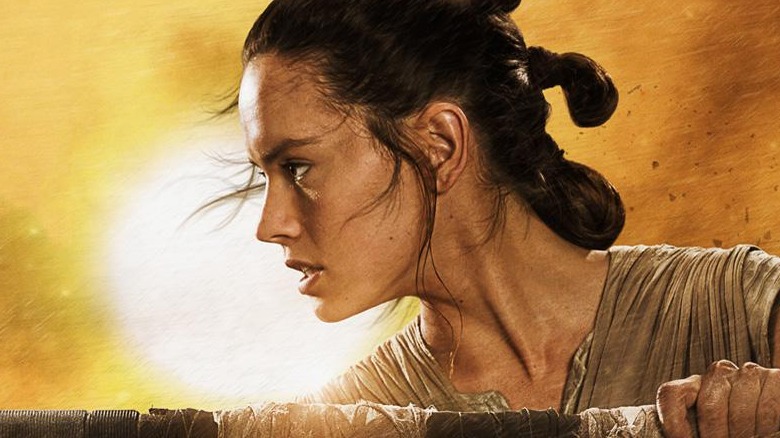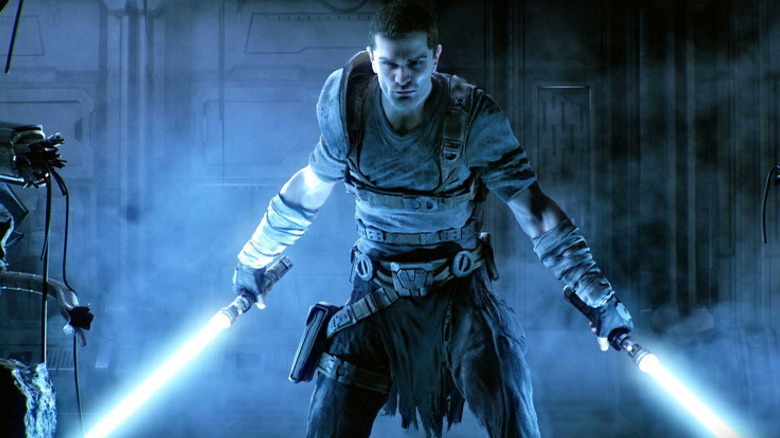The Untold Truth Of Star Wars Clone Troopers
For an army of lab-grown soldiers designed to be used as disposable people in an engineered civil war, the clone troopers have evolved into a beloved and integral part of the "Star Wars" franchise. Although the clones were largely anonymous background players in the live action "Star Wars" prequel trilogy, animated shows like "Star Wars: The Clone Wars," "Rebels," and "The Bad Batch" have done much to show that every clone is an individual in his or her own right, and capable of far more than just fighting.
But how much do we know about the true origins of the clones, their genetic makeup, and the unique destinies many of them forged? For those of you who would like to look beyond the identical faces of the clone troopers and see them for who they really are, get ready. We're about to explore the untold truth of Star Wars' clone troopers.
The result of an unsanctioned Jedi experiment
When first revealed in "Star Wars Episode II: Attack of the Clones" (2002), the clone troopers' origins are shrouded in mystery. Grown on the aquatic planet of Kamino, the clones were allegedly commissioned by the Jedi to serve as an army for the Republic. However, we later learn one of the men behind the clones' creation is the Sith Lord Count Dooku/Darth Tyrannus (Christopher Lee). Since the Jedi and Sith are enemies, how can both be responsible for the clones?
In the "Star Wars: The Clone Wars" Season 6 episode "The Lost One," we learn that the Jedi Master Sifo-Dyas was indeed the one behind the creation of the clone army. After foreseeing a major war that would devastate the galaxy, Sifo-Dyas commissioned the clones from the Kaminoans behind the backs of the Jedi Council who were against creating an army. Sifo-Dyas was then killed in a plot orchestrated by his ex-friend Count Dooku, allowing the Sith to take over the project and for Dooku to recruit the bounty hunter Jango Fett (Temuera Morrison) to serve as the template for the clones.
In the Season 6 episode "Sacrifice" of "Star Wars: The Clone Wars," Yoda has a vision of Sifo-Dyas turning into Darth Sidious. This references George Lucas' original idea that "Sido-Dyas" would be an alias used by Sidious. However, a typo changed the name and the plot point was later dropped to make "Sifo-Dyas" an actual Jedi.
Mace Windu made the clones less effective by killing Jango Fett
Ironically, while one Jedi helped create the clone troopers, another severely weakened them. In the "Bad Batch" Season 1 episode "Replacements," Kaminoans Lama Su and Nala Se reveal the supply of genetic material they harvested from Jango Fett is degrading, making it unviable for future clones. Turns out, the cloners need regular access to a donor to extract fresh samples for new clones, which is why Jango lived on Kamino in "Attack of the Clones."
However, since Jedi Master Mace Windu (Samuel L. Jackson) decapitated Jango during the Battle of Geonosis, the Kaminoans had to make do with the preserved genetic samples they had to produce new clones. As the clones formed the backbone of the Republic's war efforts, Mace could have severely depleted the army's manpower if the war effort had gone on any longer (seriously, couldn't he have just chopped off Jango's arm like every other Force-wielding duelist?)
Then again, considering how effective the clones were at slaughtering most of the Jedi, it's probably a good thing that cloning Jango Fett became harder. If the Rebels had to deal with clone troopers instead of the incredibly incompetent Stormtroopers, the original trilogy could have had a very different ending.
Clone trooper inhibitor chips originally had a very different purpose
Fans of "Star Wars: The Clone Wars" know that the reason most clone troopers killed their Jedi commanders when Emperor Palpatine initiated "Order 66" was because of the inhibitor chips implanted in their brains. Made out of genetically engineered cells, the inhibitor chips or "biochips" could take over the minds of any clone implanted with them, forcing them to slaughter even the Jedi they had grown closest to.
However, in the audiobook "Dooku: Jedi Lost," we learn the inhibitor chips initially had a very different purpose. Suggested by Jedi Master Sifo-Dyas when he commissioned the creation of the clone army, the chips were supposed to make the clones less aggressive than their original clone template Jango Fett — and to keep the clones from following orders given by rogue Jedi.
Unfortunately, when Count Dooku took over the project, the chips were modified to make the clones sleeper agents for the Sith. Ironically then, a tool designed to protect the clones from rogue Jedi was actually used to engineer the Jedi's destruction.
Several clones became independent thinkers
Although clone troopers were engineered to be less independent and "totally obedient" to their commanders, a number of clones became much more independent over the course of the war. In the "Star Wars: The Clone Wars" Season 1 episode "The Hidden Enemy," we meet a clone trooper nicknamed "Slick" who betrays the Jedi after believing that clones are being used as slave labor. Alternately, in the Season 2 episode "The Deserter," we learn that another clone left the army to raise a family and adopted the name "Cut Lawquane."
Even when clones choose to remain loyal to the Grand Army of the Republic, they can develop minds of their own. Captain Rex (Dee Bradley Baker) was able to resist Order 66 somewhat when it meant he had to kill his friend Ahsoka Tano (Ashley Eckstein). Likewise, the "defective" clones from "The Bad Batch" have very unique personalities, displaying greater independence to the point where the inhibitor chips don't work on most of them.
So, how did all these clones evolve past their initial genetic programming? In many cases, it was a question of nature versus nurture. Although the clones were raised in a controlled and isolated environment on Kamino, once on the battlefield, they needed to adapt to new situations constantly. Coupled with the fact that many Jedi encouraged the clones to think more independently, it was perhaps inevitable that some clones would become more rebellious and question authority.
Clone troopers are the Star Wars version of Captain America
In "Captain America: The First Avenger" (2011), Steve Rogers (Chris Evans) first dons his famous red-white-and-blue uniform not to fight Nazis but to sell war bonds as a World War II propaganda figure. Strangely, clone troopers fulfill the same role in the Star Wars universe. The book "Star Wars Propaganda: A History of Persuasive Art in the Galaxy" reveals the propaganda put out by the Commission for the Protection of the Republic (COMPOR) uses the troopers (or the "Boys in White") as the public face of the war to garner support and encourage citizens to buy war bonds.
This raises some interesting questions. Namely, did Palpatine have clones perform in a Star Wars version of USO tours and entertain children with staged droid battles? Were they accompanied by a chorus line of singing and dancing Gungans? Is there a Bob Hope equivalent in the galaxy far, far away? Notably, Palpatine didn't use the Jedi in his COMPOR propaganda efforts, as he didn't want the public to have any sympathy for them when he had them all killed at the end of the war.
Interestingly, the cast of "The Clone Wars" did get to do a USO tour where they screened episodes of the show for military families and performed meet-and-greets. "Star Wars" might be pretend, but its impact on service men and women is very real.
Clones have a complicated relationship with Jango Fett
While clone troopers came to see each other as brothers and developed close bonds during the war, when it came to their "father" Jango Fett, their relationship was much more complicated. Although Jango provided the genetic material that served as the clone template and helped train the original clones, the vast majority of the clones never met Jango or formed any real relationship with him.
Jango himself didn't think particularly highly of the clones, although they represented his legacy. While he promised Obi-Wan Kenobi, "they'll do their job well" In "Attack of the Clones," in the comic book "Age of the Republic — Jango Fett #1" Jango called the clone troopers "livestock bred as cannon fodder." He felt the army was the Kaminoans' creation and did not want to relate to them.
The one exception was Boba Fett, an unaltered clone whom Jango saw as his son and true heir. After Jango was killed, Boba took on some of his father's prejudices and looked at his clone "brothers" with disdain. He took great exception to being referred to as a clone in "The Mandalorian" Season 2 episode "The Rescue" and got into fights with any Mandalorian who questioned his true parentage.
Clones can exchange their body parts
Medical science is extremely advanced in the Star Wars universe, and while some characters like Darth Vader end up in pretty bad shape after receiving cybernetic replacement parts, most people like Luke Skywalker (Mark Hamill) or Fennec Shand (Ming-Na Wen) make full recoveries after getting their prosthetics. For the most part, being fitted with mechanical arms and legs is the traditional treatment for amputees and accident victims, but that's not necessarily true for all clone troopers.
In the "Republic Commando" and "MedStar" Star Wars books by Karen Traviss, Michael Reaves, and Steve Perry, it's revealed that clone organs and body parts can be harvested from dead troopers and used as replacements for the wounded. Since the clones all come from the same genetic template, the chances of any tissue rejection are virtually nonexistent. Medics also keep a supply of freshly cloned organs to use during surgery.
Of course, fighting in a war still means many clones end up with missing limbs, damaged body parts, and ugly scars. Even so, many clone troopers wear these markings with pride, seeing them as evidence of their service.
Multiple clones were born defective
The "defective" clones in "The Bad Batch" were all born with genetic mutations that made them stronger, smarter, and more capable soldiers. This drives the cloners on Kamino to intentionally emphasize these mutations and turn them into an elite commando unit known as Clone Force 99. However, Hunter, Wrecker, Tech, and Crosshair are far from the only defective clones born on Kamino.
Indeed, the very name of their unit references "99," a clone trooper born with numerous genetic and physical defects that kept him from serving in the army. Instead, like most defective clones, he's forced to stay on Kamino and gets assigned to be a maintenance duty clone (basically a janitor). However, he made friends with other troopers and cadets in the "Star Wars: The Clone Wars" Season 3 episode "Clone Cadets" and later died getting munitions to his brothers when Kamino fell under attack in the very next episode "ARC Troopers." 99's sacrifice inspired "The Bad Batch" to name their unit after him.
Sadly, while some clones treat "defective" clones with respect and friendship, others harbor prejudices against them, like the troopers who called Clone Force 99 "The Sad Batch" in "The Bad Batch" Season 1 episode "Aftermath." In turn, the Bad Batch has its own prejudices against "ordinary" clones whom they call "regs."
A clone trooper appears in "Episode IV: A New Hope"
By the time of the original Star Wars trilogy, the clone trooper program has been phased out and replaced by a Stormtrooper army made up of regular soldiers with terrible aim and questionable combat skills. Given the accelerated aging of the clone troopers, most fans believe the clones have all died out by this point — although in Season 2 of "Star Wars: Rebels," we learn that some fan favorites like Captain Rex, Wolffe, and Gregor survived to join the Rebels and participated in the Battle of Endor in "Star Wars Episode VI: Return of the Jedi."
Other clones, however, continued serving on the other side and helped the Empire train their new recruits. A few were also assigned to active duty and donned Stormtrooper armor — including a clone named "Crag" who witnessed Jedi Master Obi-Wan Kenobi perform the infamous "You don't need to see his identification" Jedi mind trick from "Star Wars Episode IV: A New Hope."
That's right, according to the short story, "Born in the Storm" by Daniel José Older, an elderly clone trooper named Crag was stationed on Tatooine while Luke Skywalker and Obi-Wan Kenobi smuggled droids C-3PO and R2-D2 into a spaceport. While Crag wasn't the Stormtrooper brainwashed by Kenobi (that was his human commander Wanten), he continued patrolling the area with his unit until the group made their escape in the Millennium Falcon, forcing the Stormtroopers to fire on the vessel. Naturally, they missed.
One clone trooper married a Jedi
Anakin Skywalker (Hayden Christensen) defied the Jedi Order by secretly marrying Padme Amidala (Natalie Portman), but another Jedi did him one better when she fell in love with and married a clone commando from her unit. Etain Tur-Mukan was a Jedi Knight assigned to Omega Squad in "Order 66: A Republic Commando Novel." During this time, she met Darman Skirata (or clone commando RC-1136), who had been adopted by his training sergeant Kal Skirata.
The two fell in love, and Etain chose to leave the Jedi Order after disagreeing with the way the clones were treated by the Republic and Jedi views on ethics and marriage. Nevertheless, she continued to serve with Omega Squad and married Darman according to Mandalorian tradition, although they had to exchange their vows over commlinks. Tragically, their marriage took place after Order 66, although Darman's love for his wife allowed him to resist the command to kill her.
In a further ironic twist, Etain was killed when she saw a Jedi Padawan try to kill one of the clone troopers. Feeling loyal to the clones, she threw herself between them, only for the Padawan's lightsaber to slice through her. Her death devastated Darman, turning him into a shell of his former self.
Although the events of this story are now considered non-canon, the fact that Jedi do defy their Order's mandate on marriage and clones have formed close relationships with the Jedi does make it a possibility.
Clones can have children
So many fans are accustomed to the sight of clones being grown in test tubes that they forget clones are fully functional beings who can have children of their own the old-fashioned way. Clone commando Darman Skirata fathered a child with his Jedi lover Etain Tur-Mukan and ended up having to safeguard his son Venku Skirata (whom he called "Kad") after Etain was killed in the aftermath of the Clone Wars. Veku would eventually grow up and refer to Boba Fett as an "uncle," due to his father's unique relationship to him.
While this incident is now considered part of Star Wars Legends, another clone trooper once met a human woman and fathered a son who later appeared in the in-canon young adult novel "Force Collector." The clone's son, a human man named Sconto who aged normally, later opened a junk shop on the planet Utapau that held Jedi artifacts and considered himself "the best thing to come out of the Clone Wars."
But perhaps the most famous child of a clone is none other than Rey Skywalker, whose father is a clone of Emperor Palpatine. In the book "Skywalker: A Family at War," we learn the clone was created on Exegol to function as a host body for Sidious' spirit. Due to his lack of Force abilities, the clone was deemed a failure, but later escaped and fathered a daughter, continuing the Palpatine bloodline.
Clones can be Force-sensitive
This last topic is a bit tricky. For the most part, the clones created from Jango Fett cannot wield the Force. The cloners on Kamino once claimed in the novel "Darth Plagueis" that genetic material with a high percentage of midi-chlorians caused the Force to interfere with the cloning process. Thus, clone troopers are not likely to become Jedi or Sith.
Still, the Force moves in mysterious ways, and several clones have displayed unique connections to the Force, both directly and indirectly. In the game "Star Wars Battlefront: Elite Squadron" cloners on Kamino managed to create Force-sensitive clones of the Jedi Knight Falon Grey. In the "Star Wars: The Force Unleashed II" video game, Darth Vader created a Force-sensitive clone of his secret apprentice Galen Marek (aka Starkiller). And Darth Sidious was able to create Snoke, an artificial genetic "strandcast" construct with a strong connection to the dark side of the Force through a cloning process.
Even clones without Force powers can produce Force wielders. The clone commando Darman's son "Kad" was Force-sensitive thanks to his Jedi Knight mother. And although Palpatine's strandcast clone "son" did not have Force abilities, he was still able to pass on the powers of his "father" to his daughter Rey, making her a powerful Force user. Despite their apparent status as genetic copies, then, all clones have unique roles to play through the will of the Force in the Star Wars universe.
